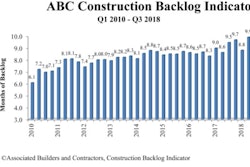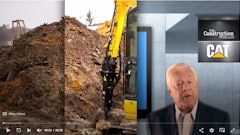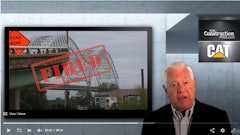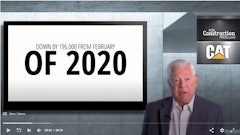Construction News Tracker is presented by Caterpillar and produced by ForConstructionPros.com.
Portions of the Federal Government are shut down. The Federal DOT furloughed 38% of its workforce — or 18,300 employees. In the Federal Transit Administration 88% of its employees are not working due to the shutdown. AASHTO is reporting that the shutdown is holding up funding increases that were part of the 2019 Transportation Appropriations Bill providing $49.3 billion for highway infrastructure. There are no federal payments being made to state agencies during the shutdown, which is seen as affecting ongoing highway planning for projects on the drawing boards, and could potentially alter future highway and infrastructure progress.
Shutdown Affects Some, But Not All, Infrastructure Programs
A new National Academy of Sciences report mandated by the Congress claims the future of the U.S. Interstate Highway System is threatened by a laundry list of deficiencies that must be addressed soon. A 20-year blueprint for action plan insists on creation of a renewal and modernization effort and calls for the federal fuel tax to be increased to pay for the improvements. The action plan also says tolls and per mile charges should be utilized to create better and more useful interstate highways. The report says many of the nation’s interstates are outmoded and over used to the point they’ve become obsolete.
An AGC analysis of Labor Department statistics shows 42 states and D.C. added workers between November 2017 and November 2018. Chief AGC Economist Ken Simonson says fewer than half the states saw monthly increases in construction employment. The industry continues to be affected by low unemployment rates and a continuing shortage of skilled workers despite record high job openings. Texas added the most jobs in 2018 followed by California, Arizona and Georgia.
Demand for concrete workers, framers, electricians and other trades is extremely high in northern California where devastating wildfires destroyed some 14,000 homes in Butte County alone in November. The lack of skilled labor is also seen in Shasta County, which was hard hit by job loss from the recession. Contractors say they had a hard time filling jobs prior to the Carr and Paradise fires which claimed 1,079 homes at an estimated market value of $292 million. The time lapse between submitting building plans and receiving local building approval can be weeks, according to contractors.
Freddie Mac claims the nation is short 2.5 million housing units and is in dire need of that inventory just to match the long-term demand. The agency says from 1968 to 2008 — a 40 year span — there was only one year in which fewer new housing units were built than in 2017. Freddie Mac estimates that over the next 10 years the nation will need to build housing to accommodate some 20 million new households, and at the current rate of construction the nation is losing ground.
The Freddie Mac report is bolstered by one from Dodge Data that says overall construction growth has been slowing since 2015 and wont pick up any steam in 2019 as housing shortfalls negate gains in nonbuilding sectors. Construction starts are not expected to expand this year. Dodge Chief Economist Robert Murray reports construction materials prices higher in the Producer Price Index with most of the increases following those of 2018, which were in the 6.5% range and mostly in the metals industry. FMI says the PPI forecast for construction put in place will increase 5.6% to $1.4 trillion, or roughly the same rate of increase as that of 2018.
ABC, Associated Builders and Contractors association, is reporting its construction backlog remains elevated beyond nine months — a historically high average despite an 8.4% drop from the second quarter of 2018. ABC Chief Economist Anirban Basau said while the third quarter saw average contractor backlog shrink the indicator remains historically elevated for only the fourth time in the history of the series. Third quarter declines were widespread while backlog decreased in three of four major regional designations while the middle states surge in industrial production helped bolster economic activity. Infrastructure category backlog fell below the 10 month threshold for the first time since 2015 while construction backlog in the commercial, institutional and heavy industrial categories remained elevated.
We encourage you to consider spending a few days later this month at World of Concrete that kicks off January 21st in Las Vegas. The industry exhibition has lots of things to consider ranging from education to displays of new equipment and ideas for you to explore. Go to worldofconcrete.com for all the details.
Peak performance potential — everyone has it. You just have to know where it’s coming from and meet it smack in the middle.
This is Construction News Tracker looking over the industry that makes the world a better place, presented by Caterpillar and produced by ForConstructionPros.com.
Follow us on social media at Twitter using #constructionnews,YouTube and Facebook as the streaming Web never ends.



















